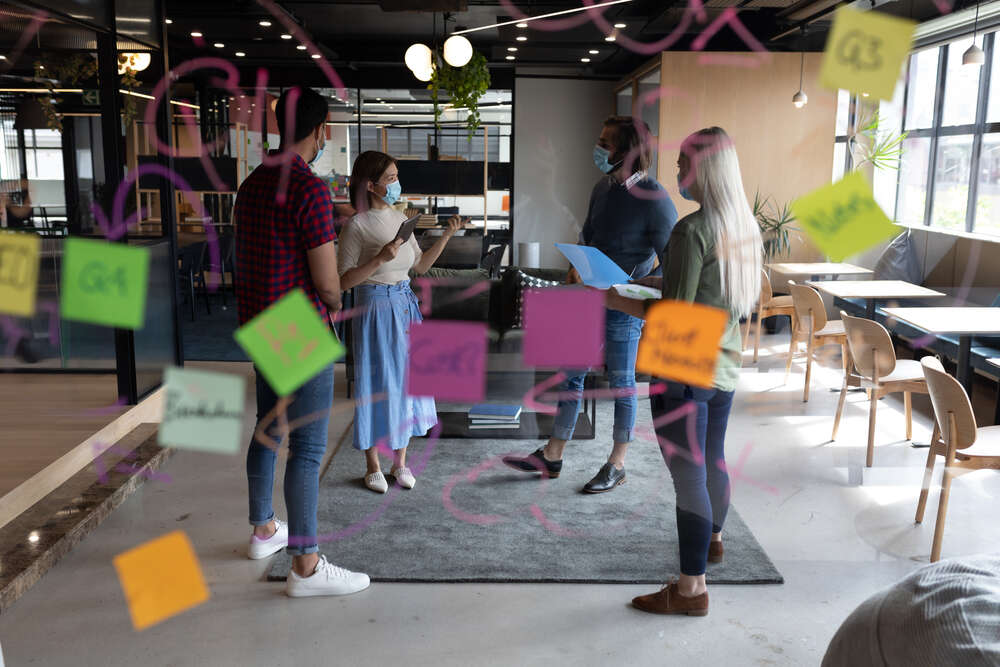
Many office workers have spent much of the past year working at home, but with vaccination rates on the rise, employers are planning a return to the workplace. Technology has a role to play in eliminating the risk of infection by managing both the office environment and employee behaviour, although the latter raises concerns about surveillance that echo debates on the national stage. Here, Tech Monitor examines some of the technologies that can help to create a Covid-safe working environment for the next phase of the pandemic.

Smart social distancing
The main vector for the transmission of Covid-19 is physical proximity. The UK government advises that workers remain at least 2m apart where possible. Some employers are turning to technology tools to maintain this social distancing within the workplace.
Several device makers offer solutions that help workers monitor their distance from each colleague. Safety equipment manufacturer RightCrowd has developed a wearable sensor that detects proximity between workers. A green light switches to orange when workers are less than 6ft away from each other, and red if they don’t immediately move apart. Red light incidents are recorded and displayed on a dashboard.
Global advisory PwC, meanwhile, has developed a contact tracking (not tracing) app that is installed on employee smartphones. The app uses geofencing to ensure that it does not track employees outside of their workplace, and, in the interest of privacy, it only records workers that have come into close contact, not where and when it took place. “It would identify if you and I came near to one another, but it wouldn’t say where we were or when,” a PwC executive told Tech Republic.
Other systems seek to monitor signs of infection among employees. Researchers at Stanford University have developed a smartwatch application they say can detect signs of infection up to ten days before the wearer notices any adverse impact on their health. This could be used to minimise transmission between colleagues, says Dr Michael Snyder, professor and chair at the Stanford Department of Genetics, who led the research.
“You could have everybody checking their temperature before they go in [to work],” he says. “If an alarm goes off [on the watch] maybe you work from home that day, or maybe your employer will require you to check, or want to read the smartwatch themselves.”
This would be more reliable than asking workers to self-report any symptoms, says Dr Snyder. “Stanford does that and everyone just ignores it if they want to go in, or they just lie,” he says.
As with national track and trace programmes, systems that seek to minimise the spread of Covid-19 by monitoring employee behaviour carry a risk of privacy invasion. Campaigners worry that – in the workplace as in society at large – monitoring practices introduced in the pandemic will be hard to roll back after it has passed.
The worry is that too often corners have been cut during a health pandemic, which need to be revisited as we get into the recovery.
Andrew Pakes, Prospect
“Our fear is that we are kind of sleepwalking into this new era of digital surveillance without even having the time to talk about it,” says Andrew Pakes, director of communications and research at trade union Prospect. “Technology is already blurring the line between home and work. The worry is that too often corners have been cut during a health pandemic, which need to be revisited as we get into the recovery.”
Covid-safe office technology: reducing the risk of transmission
Less contentious are technologies designed to sanitise the working environment. One method is to model and manage the airflow within a working space. Although the precise nature of the virus’s transmission in the air is still being debated, it is agreed that good ventilation reduces the risk.
Paul Linden is a professor of fluid mechanics at Cambridge University, and is investigating optimal air flows to reduce infection. “The best way to operate, in my view, is to use what’s called a displacement system,” he explains. “So you essentially bring in some fresh air at some low part of the space and you exhaust the contaminated air at the top of the space. That upward flow is just generally beneficial.”
To allow employers to monitor and manage the airflow within their workspaces, ‘smart building’ solution providers such as PointGuard, Spica and Fabriq have added support for air-quality sensors to their platforms. Canadian start-up Brainbox AI uses sensors to ascertain the airflow within a property over a period of six weeks, after which it can modify the air conditioning in individual rooms and areas in response to changes in occupancy and environmental conditions. Ventilation equipment manufacturers are also adding UVC lamps to neutralise the Covid-19 virus, but there is so far limited evidence on the efficacy of this approach, according to the US Federal Drug Administration.
Surfaces are now understood to be less of a vector for transmission than previously thought, but employers may nevertheless want to take every effort to reduce the risk of infection. Touchless technology, such as QR codes or iris scanners, can eliminate unnecessary contact with printers and coffee machines, and allowing employees to use their own devices at work can also reduce contact with shared surfaces.
Employers seeking to coax workers back into the office should assess how technology tools such as these can help to reassure them. But, in doing so, they should be mindful of the right to privacy – or those employees won’t be coming back for long.






